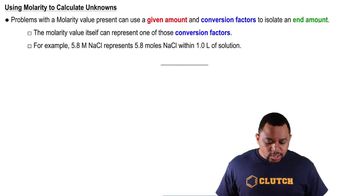Here are the essential concepts you must grasp in order to answer the question correctly.
Molarity
Molarity (M) is a measure of concentration defined as the number of moles of solute per liter of solution. It is expressed in moles per liter (mol/L) and is crucial for calculating the amount of solute in a given volume of solution. Understanding molarity allows one to determine how many moles of a substance are present in a specific volume, which is essential for stoichiometric calculations in chemistry.
Recommended video:
Moles
A mole is a fundamental unit in chemistry that quantifies the amount of substance. One mole is defined as exactly 6.022 x 10²³ entities, which can be atoms, molecules, or ions. The concept of moles is vital for converting between mass and number of particles, enabling chemists to perform calculations involving chemical reactions and concentrations.
Recommended video:
Volume Conversion
Volume conversion is the process of changing a measurement from one unit of volume to another, such as milliliters (mL) to liters (L). Since molarity is defined in terms of liters, it is necessary to convert milliliters to liters when calculating the number of moles in a solution. This conversion is essential for accurate stoichiometric calculations in chemistry.
Recommended video:
Common Conversion Factors
 Verified step by step guidance
Verified step by step guidance


